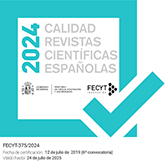Sentence topics in Italian: An analysis on the CHROME Corpus
DOI:
https://doi.org/10.3989/loquens.2021.083Keywords:
sentence topic, Italian, prosody, discourse role, syntactic structureAbstract
The present study deals with the phonetic description of sentence topics in Italian tourist guides’ speech. Topical coherence characterizes the communicative strategies that human experts adopt when delivering contents to the visitors of cultural sites. Topical progression, which ensures temporal, spatial, and referential continuity, is frequently expressed by sentence topics as well.
The relevant literature generally supports the idea of a topic accent and a rising-falling (or “hat”) contour is described as the most frequent for the unmarked topic in Italian utterance structures, but other realizations are also possible. The hypothesis that we want to test in this work is whether this variability is due to specific factors. Hence, we investigate phonetic realization of sentence topics as a function of syntactic features -structure, function and weight- and textual-pragmatic features -discourse role considering ±aboutness, ±contrastiveness, ±givenness-. Specifically, tonal events, i.e., accents and boundaries, phonetic phrasing, and disfluency phenomena were investigated. Results show that both syntactic and pragmatic factors play a role in the phonetic realization of topics, though they act at different levels. In particular, disfluencies are found to be affected by syntactic weight and givenness, while tonal events seem to depend mainly on the discourse role.
Downloads
References
Arnold, J. E., Fagnano, M., & Tanenhaus, M. K. (2003). Disfluencies signal theee, um, new information. Journal of Psycholinguistic Research, 32(1), 25-36. https://doi.org/10.1023/A:1021980931292 PMid:12647561
Avesani, C., & Vayra, M. (2005). Accenting, deaccenting and information structure in Italian dialogue. En L. Dybkjaer & W. Minker (Eds.), 6th SIGdial Workshop on Discourse and Dialogue (pp. 19-24). Lisbon, Portugal, September 2-3. ISCA Archive, http://www.isca-speech.org/archive/sigdial6
Barr, D. J. (2001). Trouble in mind: Paralinguistic indices of effort and uncertainty in communication. In C. Cavé, I. Guaïtella, & S. Santi (Eds.), Oralité et gestualité: Interactions et comportements multimodaux dans la communication (pp. 597-600). Paris: L'Harmattan.
Baumann, S. & Riester, A. (2012). Referential and lexical givenness: Semantic, prosodic and cognitive aspects. Prosody and Meaning, 25, 119-162. https://doi.org/10.1515/9783110261790.119
Bortfeld, H., Leon, S. D., Bloom, J. E., Schober, M. F., & Brennan, S. E. (2001). Disfluency rates in conversation: Effects of age, relationship, topic, role, and gender. Language and Speech, 44(2), 123-147. https://doi.org/10.1177/00238309010440020101 PMid:11575901
Brunetti, L. (2009). On the semantic and contextual factors that determine topic selection in Italian and Spanish. The Linguistic Review, 26(2-3), 261-289. https://doi.org/10.1515/tlir.2009.010
Brunetti, L., D'imperio, M. & Cangemi, F. (2010). On the prosodic marking of contrast in Romance sentence topic: evidence from Neapolitan Italian. In M. Hasegawa-Johnson (Ed.), Proceedings of the 5th International Conference on Speech Prosody 2010 (pp. 1-4). Chicago, IL, USA, May 10-14. ISCA Archive, http://www.isca-speech.org/sp2010/ITRW
Büring, D. (2016). (Contrastive) topic. In C. Féry & S. Ishihara (Eds.), The Oxford Handbook of Information Structure (pp. 64-85). Oxford: Oxford University Press. https://doi.org/10.1093/oxfordhb/9780199642670.013.002
Cataldo, V.; Orrico, R. & Crocco, C. (2021, June 21-23). Topic and focus accents in closely related varieties of Campania Italian [Poster presentation]. 4th Phonetics and Phonology in Europe (PaPE 2021), Barcelona.
Chafe, W. (1976). Givenness, contrastiveness, definiteness, subjects, topics, and point of view. In C. Li (Ed.), Subject and Topic (pp. 25-55). Cambridge, MA: Academic Press.
Cresti, E. & Firenzuoli, V. (2002). L'articolazione informativa topic-comment e comment-appendice: correlati intonativi. In A. Regnicoli (Ed.), La fonetica acustica come strumento di analisi della variazione linguistica in Italia, Atti delle XII Giornate di studio del Gruppo di Fonetica Sperimentale (pp. 153-160). Roma: Il Calamo.
Cresti, E. & Moneglia, M. (2018). The illocutionary basis of Information Structure. Language into Act Theory (L-AcT). In E. Adamou, K. Haude, & M. Vanhove (Eds.), Information Structure in Lesser-described Languages: Studies in Prosody and Syntax (pp. 359-401). Amsterdam: John Benjamins. https://doi.org/10.1075/slcs.199.13cre
Crocco, C. & Savy, R. (2007). Topic in dialogue: prosodic and syntactic features. In G. Murray & S. Renals (Eds.), Proceedings of the 8th Annual Conference of the International Speech Communication Association (pp. 114-117). Antwerp, Belgium, August, 27-31. International Speech Communication Association (ISCA)
D'Imperio, M. & Cangemi, F. (2011). Phrasing, register level downstep and partial topic constructions in Neapolitan Italian. In C. Gabriel & C. Lléo. (Eds.), Hamburg Studies on Multilingualism, 10 (pp. 75-94). Amsterdam: John Benjamins. https://doi.org/10.1075/hsm.10.05dim
Eklund, R. (2004). Disfluency in Swedish Human-human and Human-machine Travel Booking Dialogues. [PhD thesis, Linköping University]. Electronic Press.
Feldhausen, I. (2016). The relation between prosody and syntax: The case of different types of left-dislocations in Spanish. In M. Armstrong, N. Henriksen, & M. M. Vanrell (Eds.), Interdisciplinary Approaches to Intonational Grammar in Ibero-Romance (pp. 153-180). Amsterdam: John Benjamins. https://doi.org/10.1075/ihll.6.08fel
Féry, C. & Ishihara, S. (2010). How focus and givenness shape prosody. In M. Zimmerman & C. Féry (Eds.), Information Structure (pp. 36-63). Oxford: Oxford University Press. https://doi.org/10.1093/acprof:oso/9780199570959.003.0003 PMid:19898832
Firbas, J. (1987). Il funzionamento del dinamismo comunicativo nella prospettiva funzionale della frase. In R. Sornicola & A. Svoboda (Eds.), Il campo di tensione. La sintassi della Scuola di Praga (pp. 195-209). Naples: Liguori.
Firenzuoli, V. & Signorini, S. (2003). L'unità informativa di topic: correlati intonativi. In G. Marotta & N. Nocchi (Eds.), La coarticolazione. Atti delle XIII Giornate di studio del Gruppo di Fonetica Sperimentale (pp. 177-184). Pisa: Edizioni ETS.
Frascarelli, M. & Hinterhölzl, R. (2007). Types of topics in German and Italian. In S. Winkler & K. Schwabe (Eds.), On Information Structure, Meaning and Form (pp. 87-116). Amsterdam: John Benjamins. https://doi.org/10.1075/la.100.07fra
Giordano, R. & Crocco, C. (2005). Sul rapporto tra intonazione e articolazione informative. In F. Albano Leoni & R. Giordano (Eds.), Italiano parlato. Analisi di un dialogo (pp. 159-188). Naples: Liguori.
Götze, M., Weskott, T., Endriss, C., Fiedler, I., Hinterwimmer, S. Petrova, S., Schwarz, A., Skopeteas, S., & Stoel, R. (2007). Information structure. In S. Dipper, M. Götze, & S. Skopeteas (Eds.), Interdisciplinary Studies on Information Structure, Working Papers of the SFB 63, 7 (pp. 147-187). Postdam: Universitätsverlag.
Gundel, J. (1988). Universals of topic-comment structure. In M. Hammond, E. Moravcsik, & J. Wirth (Eds.), Studies in Syntactic Typology (pp. 209-239). Amsterdam: John Benjamins. https://doi.org/10.1075/tsl.17.16gun
Gundel, J., Hedberg, N. & Zacharski, R. (1993). Cognitive status and the form of referring expressions in discourse. Language, 69(2), 274-307. https://doi.org/10.2307/416535
Gundel, J., Hedberg, N., & Zacharski, R. (1997). Topic-comment structure, syntactic structure and prosodic tune. Workshop on Prosody and Grammar in Interaction (pp. 13-15). Helsinki, Finland.
Gundel, J. (2003). Information structure and referential givenness/newness. How much belongs in the grammar? Journal of Cognitive Science, 4, 177-199. https://doi.org/10.21248/hpsg.2003.8
Halliday, M. A. (1967). Notes on transitivity and theme in English. Journal of Linguistics, 3, 199-244. https://doi.org/10.1017/S0022226700016613
Hockett, C.F. (1958). A Course in Modern Linguistics. New York: Macmillan. https://doi.org/10.1111/j.1467-1770.1958.tb00870.x
Krifka, M. (2008a). What do contrastive topics and frame setters have in common? The role of addressing and delimitation in information structure. Conference on Contrastive Information Structure Analysis (CISA 2008). Mars, 18-19. University of Wuppertal.
Krifka, M. (2008b). Basic notions of information structure. Acta Linguistica Hungarica, 55(3-4), 243-276. https://doi.org/10.1556/ALing.55.2008.3-4.2
Lambrecht, K. (1994). Information Structure and Sentence Form: Topic Focus and the Mental Representation of Discourse Referents. Cambridge: Cambridge University Press. https://doi.org/10.1017/CBO9780511620607
Maslova, E. & Bernini, G. (2000). Sentence topics in the languages of Europe and beyond. In G. Bernini & M. Schwarz (Eds.), Pragmatic Organization of Discourse in the Languages of Europe (pp. 67-120). The Hague: Mouton de Gruyter.
Mathesius, W. (1929). Sulla cosiddetta articolazione attuale della frase. In R. Sornicola & A. Svoboda (Eds.), Il campo di tensione. La sintassi della Scuola di Praga (pp. 181-194). Liguori.
Mereu, L. & Frascarelli, M., (2006). L'interfaccia Sintassi-Fonologia. Interpretazione e implicazioni teoriche. In R. Savy & C. Crocco (Eds.), Analisi prosodica. Teorie, modelli e sistemi di annotazione. Atti del II Convegno Nazionale dell'Associazione Italiana di Scienze della Voce (pp. 256-285). Mantova: EDK Editore.
Mereu, L. & Trecci, A. (2004). Focus sul topic. In F. Albano Leoni, F. Cutugno, M. Pettorino, & R. Savy (Eds.), Atti del Convegno Il Parlato italiano [CD-ROM]. Naples: M. D'Auria Editore.
Origlia, A., Savy, R., Poggi, I., Cutugno, F., Alfano, I., D'Errico, F., Vincze, L., & Cataldo, V. (2018). An audiovisual corpus of guided tours in cultural sites: Data collection protocols in the CHROME Project. In B. N. De Carolis, C. Gena, T. Kuflik, A. Origlia, & G. E. Raptis (Eds.), Proceedings of the 2018 AVI-CH Workshop on Advanced Visual Interfaces for Cultural Heritage (pp. 1-4). https://dl.acm.org/doi/10.1145/3206505.3206597
Petrone, C., & D'Imperio, M. (2011). From tones to tunes: Effects of the f0 prenuclear region in the perception of Neapolitan statements and questions. Prosodic Categories: Production, Perception and Comprehension (pp. 207-230). Berlin: Springer. https://doi.org/10.1007/978-94-007-0137-3_9
Petrone, C., & Niebuhr, O. (2014). On the intonation of German intonation questions: The role of the prenuclear region. Language and Speech, 57(1), 108-146. https://doi.org/10.1177/0023830913495651 PMid:24754223
Reinhart, T. (1981). Pragmatics and linguistics: An analysis of sentence topics in pragmatics and philosophy. Philosophica, 27(1), 53-94. https://doi.org/10.21825/philosophica.82606
Sbranna, S., Ventura, C., Albert, A., & Grice, M. (2021). Prosodic expression of information status in Italian. [Poster presentation]. 4th Phonetics and Phonology in Europe (PaPE 2021), June, 21-23, Barcelona.
Sgall, R. (1972). Topic, fuoco e ordine degli elementi nelle rappresentazioni semantiche. In R. Sornicola & A. Svoboda (Eds.), Il campo di tensione. La sintassi della Scuola di Praga (pp. 195-209). Liguori.
Shriberg, E.E. (1994). Preliminaries to a Theory of Speech Disfluencies [Unpublished PhD thesis]. University of California.
van Kuppevelt, J. (1995). Discourse structure, topicality and questioning. Journal of Linguistics, 31, 109-149. https://doi.org/10.1017/S002222670000058X
Voghera, M. & Turco, G. (2008). Il peso del parlare e dello scrivere. In M. Pettorino, A. Giannini, M. Vallone & R. Savy (Eds.), La comunicazione parlata (pp. 727-760). Naples: Liguori.
von Heusinger, K. (2002). Information structure and the partition of sentence meaning. In E. Hajičová, P. Sgall, J. Hana & T. Hoskovec (Eds.), Prague Linguistic Circle Papers: Travaux du Cercle Linguistique de Prague nouvelle série, 4 (pp. 275-305). Amsterdam : John Benjamins. https://doi.org/10.1075/plcp.4.14heu
Published
How to Cite
Issue
Section
License
Copyright (c) 2021 Consejo Superior de Investigaciones Científicas (CSIC)

This work is licensed under a Creative Commons Attribution 4.0 International License.
© CSIC. Manuscripts published in both the print and online versions of this journal are the property of the Consejo Superior de Investigaciones Científicas, and quoting this source is a requirement for any partial or full reproduction.
All contents of this electronic edition, except where otherwise noted, are distributed under a Creative Commons Attribution 4.0 International (CC BY 4.0) licence. You may read the basic information and the legal text of the licence. The indication of the CC BY 4.0 licence must be expressly stated in this way when necessary.
Self-archiving in repositories, personal webpages or similar, of any version other than the final version of the work produced by the publisher, is not allowed.














